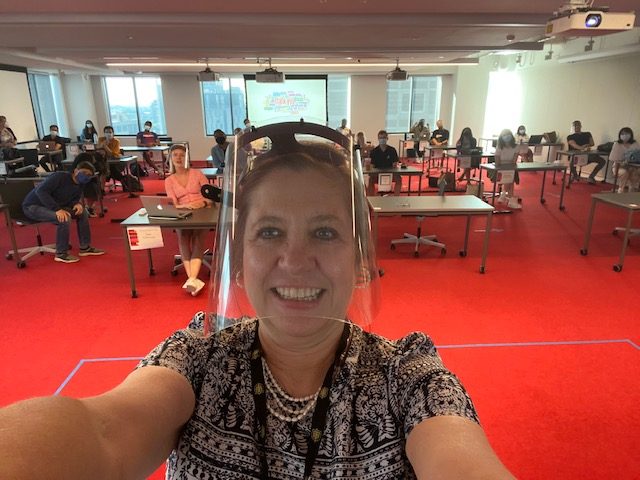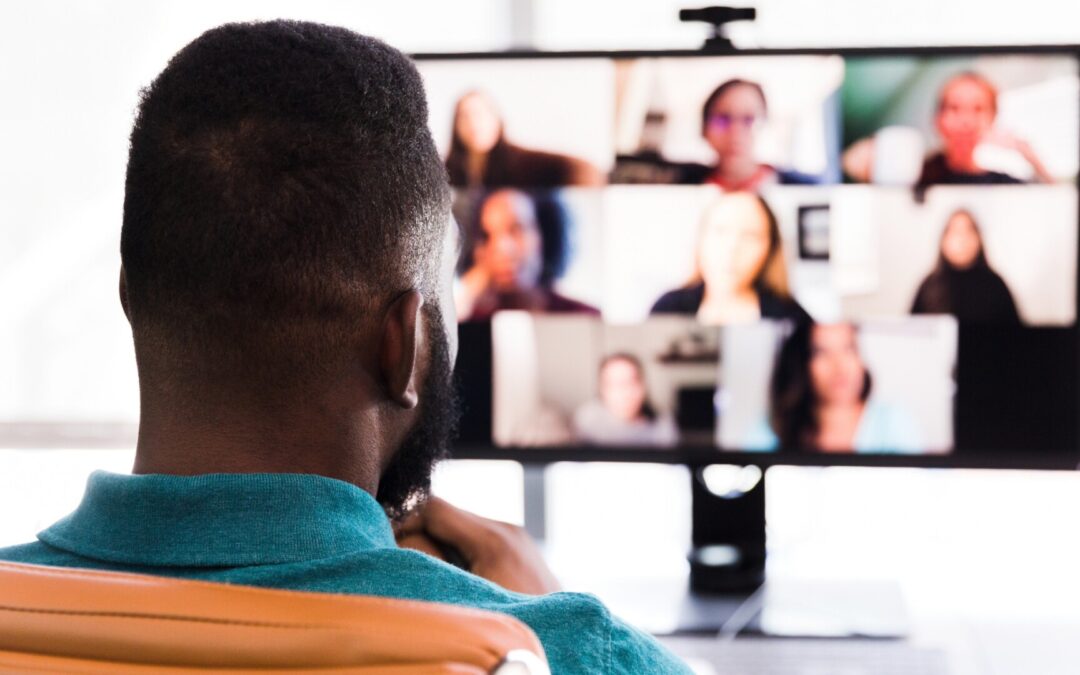
6 Lessons I Learned from Teaching in a COVID-era Classroom
If teaching had a playbook, it might include lesson plans, class materials, presentations, exercises, activities, and assessments that support the course learning objectives. When I walk into a classroom, I’ve got my playbook ready for that day’s class. But last week’s classes were different from any other, and I wasn’t sure what to expect. That’s when I taught a face-to-face summer course at a college in Cambridge, Massachusetts to pilot in-person teaching for courses in the fall. This was a daunting experience filled with uncertainty and trepidation, one that many educators will be faced with come fall. Here are some lessons that I learned from that experience.
A few months ago, the startling realization of a raging pandemic catapulted students and faculty online in a matter of days. The shift to online teaching was a case study in agility. Faculty from our campuses around the world pooled their knowledge and technical platform experience as we prepared to welcome students to our online campus. After a few days of teaching online, we became accustomed to rows of boxes on a computer screen instead of rows of students in a classroom.
I can’t say that I’m an expert in pedagogy and teaching strategies but having pioneered teaching in a COVID-era classroom with twenty-seven students, I have a unique perspective that is different from classes I have taught over the past twenty-three years. If you are planning to join your students in the classroom this year, consider the opportunity to rethink what that means for you.

Preparing for a COVID-era class takes more time and thoughtfulness than before.
The decision to enter the classroom wasn’t an easy one to make. Friends and family voiced their concerns, and most of us had questions about how an in person class would run. Given that we would be the only class on campus at the time, the associated risk seemed manageable. After thinking through the emotional and psychological aspects of teaching in a COVID-era classroom, I started to plan. Christine I. McClure taught an in-person class this summer at Embry-Riddle Aeronautical University in Daytona Beach, Florida. She notes that “there is definitely a learning curve to COVID-style teaching, and it is a lot of work”. Be sure to set aside enough time for planning. In my case, a colleague and I had originally designed this new course, assuming that it would be taught in a face-to-face classroom. Once our classes moved to virtual delivery, I redesigned the course accordingly. The final version of the course turned out to be different than the other two versions since safety guidelines for student interaction and movement in a confined space had to be factored in. Fortunately, I had allocated enough time in my schedule for the course redesign and preparation.
There are lots of moving parts involved in a COVID-era classroom.
I didn’t quite realize how much the physical classroom itself is an element of learning, especially since the topics that I teach lend themselves to interactivity and experiential learning. When I entered the school for a preliminary site visit, aside from the fact that there were no students or faculty the building, it felt different. The lobby welcomed guests to evenly space themselves as they entered through the key card turnstiles. Crowded elevators are now limited to only two people per ride, with emblems on the floor that mark the distanced location where each rider should stand. The classroom traffic flow was marked: entry and exit are limited to specific doors; signage marks the movement among seats/tables in the classroom, just like in the grocery store.
If students will be moving around in your classroom, consider how that might work. Movement in the classroom should be thoughtfully choreographed to factor in safety guidelines. In my case, twenty-seven students were situated in a flexible classroom with six feet between each seat/table. Consider how activities such as team discussions and bathroom breaks might be handled to minimize movement and contact within the classroom. For example, during the break, students were invited to exit the classroom in groups in order to minimize the traffic in the bathrooms.
Classes that feature a good amount of group work may require alterations. Instead of working side-by-side, student teams will need to work across physical distance in the classroom, making it difficult to hear one another (and read one’s lips) while wearing masks and face shields. I used a lavalier microphone initially but abandoned it after the microphone clip slipped off my face shield one too many times. It took a while for us to learn how to modulate our voices so that everyone could be heard and understood.
What are the considerations for your classroom?
Take advantage of available meeting rooms and other spaces.
Consider how your class is “typically” structured. Make use of any space that is available to you outside of the classroom. We were fortunate to have access to team rooms (smaller meeting rooms) where 3 to 4 students could meet comfortably within safety protocols. Chairs were positioned on marked locations to ensure proper distancing. It is worth noting that working in teams requires discipline and constant reminders to limit contact and reinforce new habits.
There were many safeguards in place to ensure a safe academic environment. A good amount of outreach was sent to students before the start of the class which probably contributed to their awareness. The course, entitled Persuasion and Influence, was an intensive 4-day elective for master’s students from around the world. There were several pre-requisites for students to join the class: participants could join in-person only and then only after completing a mandatory quiz to acknowledge that they had watched the “Back to campus” information video and completed a self-declaration. Students that had not properly quarantined in advance of the course start date (if required) were not allowed to join the class. In addition, daily alerts were sent to each student to inquire about their physical well-being.
It’s important to set the tone for your students.
Being in a COVID-era classroom is a brave choice. The way that we handle this choice, as educators, is up to us. Many students in our classrooms will be apprehensive about being back to school. Many of our faculty will be apprehensive as well. It’s up to us to set the stage and the tone for our students’ learning experience.
I anticipated what the students’ mindset might be, and we spent a lot of time in open discussion at the beginning of class. Just like with other courses, we started with student introductions and expectations for the course. Typically, I ask students to jot down their expectations for the course and for learning, and then post their responses on the wall at the front of the room. We use this to get to know one another and introduce the course. In this classroom, however, I used a Mentimeter poll for students to share their thoughts in order to minimize movement and contact.
Many of the comments revealed what students were thinking: “I hope to be COVID-free by the end of class,” “I’m happy just to be around people again.” Students talked about how they were feeling and what it means to be back in a classroom after months away, much in the way that I noted in a recent essay, Canary in the Coal Mine or Canary in the Classroom? One of our guest speakers acknowledged the courage that students demonstrated by being in the classroom. We talked about how we are changing habits in our learning environment and about restrictions and ways to encourage psychological and physical safety in the classroom. Consider different ways that you might enforce these new habits in your classroom.
In a recent McKinsey report, Amy Edmondson notes that “For many people during the pandemic, the explicitness of the physical lack of safety has been experienced as a shared fear, which has allowed them to be more open and intimate and more able to voice their thoughts and concerns with colleagues. This collective fear thus becomes a potential driver of collaboration and innovation, further contributing to an open environment for producing and sharing ideas that under normal conditions may have remained unshared.” Glimpses of this collective fear surfaced during the four-day course and contributed to a collective sense of community.
Make safety a shared responsibility in the classroom to reinforce new habits.
This one might seem obvious, but I wasn’t quite sure how to approach the topic until the students were in the classroom. The floor at the front of the room was marked with painter’s tape around the “professor’s bubble” that included the podium. In order to minimize physical contact, the goal is to stay within the “bubble” and for students to stay in their physically distanced seats. “I expect that we are going to give each other feedback and keep each other honest. So if you’re observing somebody that’s not distancing, it’s okay to mention it. If you see me walking out of my bubble, raise your hand and let me know”, I explained. Ten minutes later, a student raised her hand: “You’re outside of the bubble, professor.” From that point, we established the norm to remind one another, constantly, to follow safety precautions.
With safety at the forefront, it’s important to rethink human interaction and creative ways for students to stay engaged with the course topics while meeting learning objectives.
Modify your teaching strategies to take advantage of technology.
Students presented a preview of their project on the last day of class, which would typically involve a presentation by the entire team at the front of the classroom. One team member would insert a USB drive in the podium computer and then remove it when they were finished. In order to minimize contact and movement I set up a section in Canvas where teams uploaded the presentations. I downloaded each presentation, thereby avoiding the need for any student to touch the podium computer. We established a rule that only one person per team could use the slide clicker, which they picked up and returned to a table. After each use, I wiped down the device and anyone that touched it washed their hands. Student teams stood at the front of the classroom (in the “professor’s bubble”), physically distanced, and delivered their presentations.
We used technology to bring the outside guest speakers closer to the class when students joined the Zoom session from their computers while they were seated in the classroom, and the guest speaker was projecting on a large screen at the front of the room. There are other techniques that you may want to try in your environment. For example, when students dispersed to team rooms, I opened a Zoom session for the entire class. One student joined from each team in order to connect the entire class from their physical team rooms. We also experimented with using WhatsApp to send instructions and questions to each team while they were in their team rooms. Using virtual technology in a physical setting is still a work-in-progress but it can be useful when some of the students are dispersed, effectively tethering all of us together.
I can say that I felt differently from the first day of class to the last day. The kickoff was a bit quirky – meeting one another for the first time, adjusting masks, seating arrangements, safety protocols and teaching a course I had not taught before. What surprised me the most about this in-class experience? It will take more than a four-day course to change habits that we have developed over years of teaching and learning. I was surprised by how our “pioneer community” of learners had developed a sense of camaraderie during our time together, perhaps because of our shared experience and the newness of it all. With practice and persistence, hopefully the precautions that we have taken will result in a safe learning environment for all of us. I also discovered a silver lining: due to the lighter-than-usual traffic, my 75-minute commute has been cut in half.
Are you a teacher who has taught in a COVID-era classroom?
How did your prepare for it? What was the student experience?

About the author:
Pamela Campagna MBA, CMC is the President of BLUE SAGE Consulting, Inc. a certified women-owned management consulting firm. Pamela is a board member and chair of the Marketing and Membership Committee of CMC-Global Institute, a virtual global community for professional management consultants. She is also a Professor of Practice at Hult International Business School in Cambridge, MA where she has been teaching leadership, strategy and management courses since 2014.


